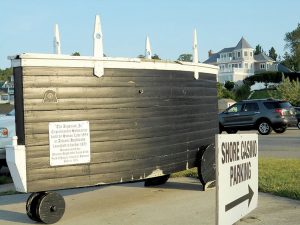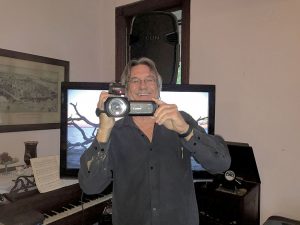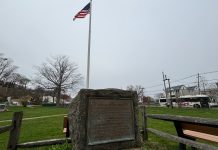You won’t find Simon Lake on a Monmouth County map. Mister Simon Lake was the inventor of the submarine. If you’re familiar with his name and fame, you still might be surprised to learn that his first under water excursions were in our very own Two Rivers. In 1894 Simon Lake piloted a wheeled wooden submersible along the bottom of Shrewsbury River. Yes, you read that correctly – it was a wooden submarine on wheels!
Speaking at the Atlantic Highland Historical Society recently, video historian John Schneider told an intrigued audience how Simon Lake made undersea navigation possible. Lake’s is a story of ingenuity, persistence, disappointments, and ultimately success, tempered by delayed recognition.
If you’ve ever had a meal at the Shore Casino or commuted to New York via the Seastreak Ferry you’ve been on Simon Lake Drive in Atlantic Highlands, named for the inventor. You may have seen the replica there of Lake’s Argonaut Junior, given to the town by the Atlantic Highlands Lions Club in 1994.
Simon Lake was born in Pleasantville in 1866. His father was an inventor, as well as a developer of Atlantic City and Ocean City. But young Simon’s talents weren’t simply inherited. He developed his engineering skills working in his father’s foundry and machine shop. He was also captivated by the Nautilus submarine he read about in Jules Verne’s “Twenty Thousand Leagues Under The Sea.” His prototype submarine was in fact named after the scientific name for nautilus, “argonauta.”

After working in Baltimore making winding gears for oyster boats, Simon Lake moved to Atlantic Highlands in 1893, primarily because its waterfront afforded him a shallow water lab for his experiments. He lived with his Uncle Somers Champion’s family on Bay View Avenue while he tinkered with rudimentary submarine designs.
Lake came up with a way to generate the positive publicity he needed a few weeks later. In front of dozens of newspaper reporters and a large crowd in Atlantic Highlands, Lake took the Argonaut Junior to the bottom of the harbor and surfaced with a handful of starfish and clamshells. Skeptical observers murmured that objects had been stowed on board ahead of time.
The U.S. Navy was also not convinced Lake’s design was worthwhile. Competitor John Philip Holland was conducting submersible operations in Raritan Bay around the same time, and in 1897 his company was the first to win a government submarine contract. The thwarted Simon Lake began selling his submarines to a number of other countries in the first years of the 20th century, among them Austria, Germany, and Russia. Eventually the United States government did come around to Lake’s innovations when it bought his sub- marines during the buildup for World War I. Simon Lake’s enduring efforts won his company many Navy con- tracts over the years. In 1964, the Navy built submarine ten- ders in what was called the Simon Lake class. The USS Simon Lake serviced the fleet for an enviable 35 years, duplicating Lake’s own persistence.

So, how DO you get to Simon Lake? Simon Lake moved his company’s operations to Bridgeport on Long Island Sound in 1907. When he passed away in 1945, he was laid to rest where he lived during those years in Milford, Connecticut. You can visit his unassuming gravesite in the Kings Highway Cemetery.
Simon Lake, adopted son of Atlantic Highlands, is acknowledged today as the Father of the Submarine.














